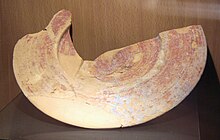Mogador Island
Île de Mogador
جزيرة موغادور | |
|---|---|
 Mogador island from Essaouira harbour | |
| Country | |
| Region | Marrakesh-Safi |
| Province | Essaouira Province |



Mogador island (French: Île de Mogador) is the main island of the Iles Purpuraires near Essaouira in Morocco. It is about 3 kilometers long and 1.5 kilometers wide, and lies about 1.5 kilometers from Essaouira.[1]
History
The Carthaginian navigator Hanno visited and established a trading post in the area in the 5th century BC, and Phoenician artifacts have been found on the island.[1]
Around the end of the 1st century BC or early 1st century AD, Juba II established a Tyrian purple factory, processing the murex and purpura shells found in the intertidal rocks at Essaouira and the Iles Purpuraires. This dye colored the purple stripe in Imperial Roman Senatorial togas.
Roman merchants settled in the island under Augustus creating a small village: a Roman house with foundations, and also artifacts and coins, were also found on the island. Mogador and the nearby Iles Purpuraires were tied[2] to Mauretania Tingitana by merchant ships in the first and second centuries of the Roman Empire.
From the first to the fourth century the island was connected to Mauretania Tingitana with roman ships that regularly went to the Roman Sala Colonia: this port of Sala (now disappeared) was connected with commercial roman ships with Anfa and this island on the coast of actual southern Morocco.
In 1844, the French Navy besieged the island, and it fell to the French in France's brutal Bombardment of Mogador.[3]
It has now been designated as a nature reserve, and it cannot be visited without an official authorization.
Flora and fauna
A survey of falcons on the island in 2014 found evidence of Eleonora's falcon (Falco eleonorae) crippling and imprisoning live prey for later use. Abdeljebbar Qninba of Mohammed V University, Rabat, and colleagues, found small birds with missing flight and tail feathers trapped, or hiding in small holes or cavities. It is thought either the falcons plucked feathers to keep the birds as a food source for later, or alternatively, the prey are escaping from the falcons by finding refuge in nearby holes.[4]
References
- ^ a b Itineraria Phoenicia Edward Lipiński p 466
- ^ UNA ETAPA EN LA RUTA MOGADOR-CANARIAS: CERÁMICA ROMANA EN LANZAROTE Y SU RELACIÓN CON HALLAZGOS SUBMARINOS (in Spanish)
- ^ E.J. Brill's first encyclopaedia of Islam, 1913–1936, Volume 9 Martijn Theodoor Houtsma p 550
- ^ "Falcons imprison birds to eat later". New Scientist. 229 (3055): 17. 9 January 2016.
See also


